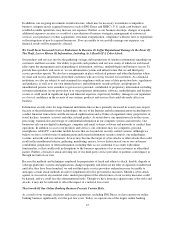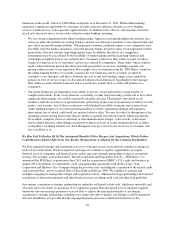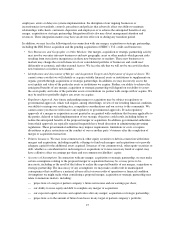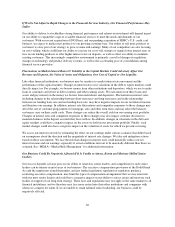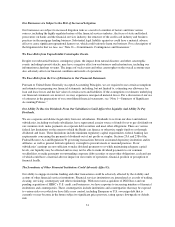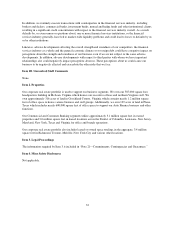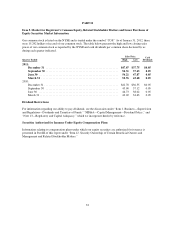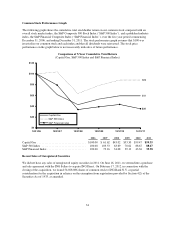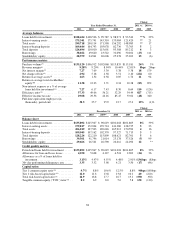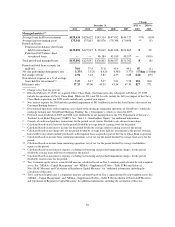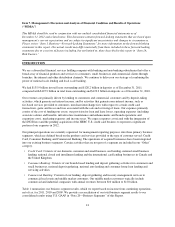Capital One 2011 Annual Report Download - page 51
Download and view the complete annual report
Please find page 51 of the 2011 Capital One annual report below. You can navigate through the pages in the report by either clicking on the pages listed below, or by using the keyword search tool below to find specific information within the annual report.Our Businesses are Subject to the Risk of Increased Litigation.
Our businesses are subject to increased litigation risks as a result of a number of factors and from various
sources, including the highly regulated nature of the financial services industry, the focus of state and federal
prosecutors on banks and the financial services industry, the structure of the credit card industry and business
practices in the mortgage lending business. Substantial legal liability against us could have a material adverse
effect or cause significant reputational harm to us, which could seriously harm our business. For a description of
the litigation risks that we face, see “Note 21—Commitments, Contingencies and Guarantees.”
We Face Risks from Unpredictable Catastrophic Events.
Despite our substantial business contingency plans, the impact from natural disasters and other catastrophic
events, including terrorist attacks, may have a negative effect on our business and infrastructure, including our
information technology systems. The impact of such events and other catastrophes on the overall economy may
also adversely affect our financial condition and results of operations.
We Face Risks from the Use of Estimates in Our Financial Statements.
Pursuant to United States Generally Accepted Accounting Principles, we are required to use certain assumptions
and estimates in preparing our financial statements, including, but not limited to, estimating our allowance for
loan and lease losses and the fair value of certain assets and liabilities. If the assumptions or estimates underlying
our financial statements are incorrect, we may experience unexpected material losses. For a discussion of our use
of estimates in the preparation of our consolidated financial statements, see “Note 1—Summary of Significant
Accounting Policies.”
Our Ability To Receive Dividends From Our Subsidiaries Could Affect Our Liquidity And Ability To Pay
Dividends.
We are a separate and distinct legal entity from our subsidiaries. Dividends to us from our direct and indirect
subsidiaries, including our bank subsidiaries, have represented a major source of funds for us to pay dividends on
our common stock, make payments on corporate debt securities and meet other obligations. There are various
federal law limitations on the extent to which the Banks can finance or otherwise supply funds to us through
dividends and loans. These limitations include minimum regulatory capital requirements, federal banking law
requirements concerning the payment of dividends out of net profits or surplus, Sections 23A and 23B of the
Federal Reserve Act and Regulation W governing transactions between an insured depository institution and its
affiliates, as well as general federal regulatory oversight to prevent unsafe or unsound practices. If our
subsidiaries’ earnings are not sufficient to make dividend payments to us while maintaining adequate capital
levels, our liquidity may be affected and we may not be able to make dividend payments to our common
stockholders, to make payments on outstanding corporate debt securities or meet other obligations, each and any
of which could have a material adverse impact on our results of operations, financial position or perception of
financial health.
The Soundness of Other Financial Institutions Could Adversely Affect Us.
Our ability to engage in routine funding and other transactions could be adversely affected by the stability and
actions of other financial services institutions. Financial services institutions are interrelated as a result of trading,
clearing, servicing, counterparty and other relationships. With our recent acquisition of ING Direct and our
pending acquisition of HSBC’s U.S. credit card businesses, we have exposure to increasing numbers of financial
institutions and counterparties. These counterparties include institutions and counterparties that may be exposed
to various risks over which we have little or no control, including European or U.S. sovereign debt that is
currently or may become in the future subject to significant price pressure, rating agency downgrade or default
risk.
31






